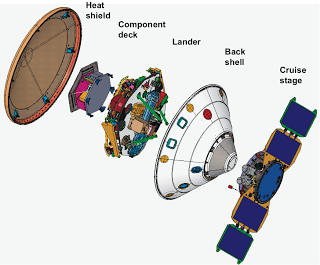Astronomy

- Phoenix's Microscope Receives First Sample
After 28 Sols, or Martian days, the latest images beamed back to NASA from Phoenix, like the one above, show that the lander is continuing to do its job successfully on Mars. Phoenix's robotic arm, in the picture on the top right corner, has just...
- Phoenix Discovers Ice
The animation at right displays the finding of ice on Mars by Phoenix. As the previous posts about Phoenix on this blog show, Phoenix's mission was to find water on the polar regions of Mars, and it has done exactly that. Through digging, it uncovered...
- Phoenix Components
The Phoenix spacecraft, launched in August 2007, is landing on Mars this Sunday. It is composed of many different types of components that will help conduct its research on Mars. Some of these instruments are from previous missions that did were abandoned....
- The Phoenix
If you haven't found out already, the Phoenix spacecraft is scheduled to land this Sunday, May 25, 2008 on Mars. So what exactly is the Phoenix spacecraft and mission? Basically, the Phoenix spacecraft is a lander, that will land on Mars and, using...
- Phoenix Is Go For Landing
Phoenix is go for landing. The Phoenix Spacecraft is currently being prepared for its landing on Mars, to take place on this Sunday, May 25, at about 7:30 P.M. NASA has put up many ways that you can stay informed and current with information about the...
Astronomy
Seven Minutes of Terror!

Seven Minutes of Terror!
That's what the spacecraft and the team working on the Phoenix spacecraft will go through, when Phoenix attempts a landing this Sunday on Mars. This is when the space vehicle will first hit the atmosphere of Mars, go through parachute deployment, and finally hit the surface, with many more things in between. However, since signals between the Earth and Mars take about ten minutes to travel, the crew working on Phoenix will get the first signals that the landing process has started, after the whole landing sequence has actually ended! So how will Phoenix try to avoid the fate of many previous Martian missions and not splatter on the ground?
Phoenix will have the support of three Mars orbiters, that are currently circling the planet, NASA's Mars Reconnaissance Orbiter and the Mars Odyssey and ESA's Mars Express. The signals sent by Phoenix during its entry on to Mars will rely on the successful relay of the message to Earth by these orbiters. This is the first time any Mars lander will have the support of the relay system, both for landing and on the surface.
First, Phoenix will enter the Martian atmosphere at 21,000 km/h (13,000 m/h). A parachute, very similar to the Viking spacecrafts', will open at 12.6 km (7.8 miles) above Mars. The parachute will slow down the hurtling spacecraft with drag. Meanwhile, as Phoenix will near the surface, an onboard radar will give the altitude and velocity of the descent of the Phoenix spacecraft, allowing the onboard computer to make adjustments as necessary. This step is necessary, since upon entering and until the parachute opening, big errors in positioning can be made.
After two minutes of descent with the parachute, Phoenix will jettison its back shell, to which the parachute is attached. Then Phoenix will free fall, for half a second, towards the surface of Mars, and then ignite its engines. Nine engines from the total twelve will pulse for 10 seconds. The remaining three will fire steadily, for stability. Right before touchdown, as a finishing touch, the vehicle is turned, to increase the amount of sunlight that will fall on the solar panels.
The Jet Propulsion Laboratory will be able to give course adjustments if necessary up to three hours before Phoenix lands on Mars. However, during the landing, these people can only stand back, watch and hope, while they endure the seven minutes of terror.
The following video shows an animated launch and landing of the Phoenix, and gives a very nice visual of the above process:
Image from NASA.
- Phoenix's Microscope Receives First Sample
After 28 Sols, or Martian days, the latest images beamed back to NASA from Phoenix, like the one above, show that the lander is continuing to do its job successfully on Mars. Phoenix's robotic arm, in the picture on the top right corner, has just...
- Phoenix Discovers Ice
The animation at right displays the finding of ice on Mars by Phoenix. As the previous posts about Phoenix on this blog show, Phoenix's mission was to find water on the polar regions of Mars, and it has done exactly that. Through digging, it uncovered...
- Phoenix Components
The Phoenix spacecraft, launched in August 2007, is landing on Mars this Sunday. It is composed of many different types of components that will help conduct its research on Mars. Some of these instruments are from previous missions that did were abandoned....
- The Phoenix
If you haven't found out already, the Phoenix spacecraft is scheduled to land this Sunday, May 25, 2008 on Mars. So what exactly is the Phoenix spacecraft and mission? Basically, the Phoenix spacecraft is a lander, that will land on Mars and, using...
- Phoenix Is Go For Landing
Phoenix is go for landing. The Phoenix Spacecraft is currently being prepared for its landing on Mars, to take place on this Sunday, May 25, at about 7:30 P.M. NASA has put up many ways that you can stay informed and current with information about the...
